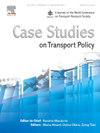Airport capacity prediction and optimal allocation for strategic air traffic flow management at Sao Paulo/Guarulhos International Airport
IF 2.4
Q3 TRANSPORTATION
引用次数: 0
Abstract
Demand–capacity imbalances are a major cause of inefficiencies in the air transportation system, accounting for a significant part of flight delays and disruptions. Efficiently addressing these imbalances through air traffic flow management is key for improving system performance. If taken at the strategic level, flow management decisions have the potential to increase operational predictability and reduce costs for airspace users by transferring expected delays to the ground before departure, where it is safer and cheaper to absorb them. However, strategic flow management planning is a challenge for traffic managers due to the stochastic and dynamic nature of airport and airspace capacity. This paper leverages machine learning and optimization methods to develop a decision support framework for strategic air traffic flow management at Sao Paulo/Guarulhos International Airport (GRU) in Brazil. First, an airport capacity prediction model is learned from historical meteorological and throughput data. Random Forests is used in a regression setting for the supervised learning problem, being able to provide not only a point prediction of arrival capacity but also an empirical predictive distribution based on the Quantile Regression Forests approach. An analysis of feature importance reveals that ceiling and convective weather are the most important factors affecting arrival capacity at GRU. A stochastic optimization model for capacity allocation is then used to prescribe the optimal airport acceptance rates for Ground Delay Program planning based on the capacity forecasts and their estimated uncertainty. When applied to an actual test case of demand–capacity imbalance at GRU, the solution provided by the framework is found to generate a reduction in total delay costs of up to 10%, revealing an improvement over the current practice solely based on tactical airborne delays.
圣保罗/瓜鲁洛斯国际机场战略空中交通流量管理的机场容量预测和最佳分配
需求与运力的不平衡是造成航空运输系统效率低下的一个主要原因,也是造成航班延误和中断的重要原因。通过空中交通流量管理有效解决这些不平衡问题是提高系统性能的关键。如果在战略层面上进行,流量管理决策有可能提高运营的可预测性,并通过在起飞前将预期的延误转移到地面来降低空域用户的成本,因为在地面上吸收延误更安全,成本更低。然而,由于机场和空域容量的随机性和动态性,战略流量管理规划对交通管理人员来说是一个挑战。本文利用机器学习和优化方法,为巴西圣保罗/瓜鲁洛斯国际机场(GRU)的战略空中交通流量管理开发决策支持框架。首先,从历史气象和吞吐量数据中学习机场容量预测模型。随机森林用于监督学习问题的回归设置,它不仅能够提供到达容量的点预测,还能够提供基于分位数回归森林方法的经验预测分布。特征重要性分析表明,顶棚和对流天气是影响GRU到达能力的最重要因素。然后利用容量分配的随机优化模型,根据容量预测及其估计的不确定性,规定了地面延误计划规划的最优机场接受率。当应用于GRU需求-容量不平衡的实际测试案例时,发现该框架提供的解决方案可以减少总延迟成本高达10%,揭示了仅基于战术机载延迟的当前实践的改进。
本文章由计算机程序翻译,如有差异,请以英文原文为准。
求助全文
约1分钟内获得全文
求助全文

 求助内容:
求助内容: 应助结果提醒方式:
应助结果提醒方式:


